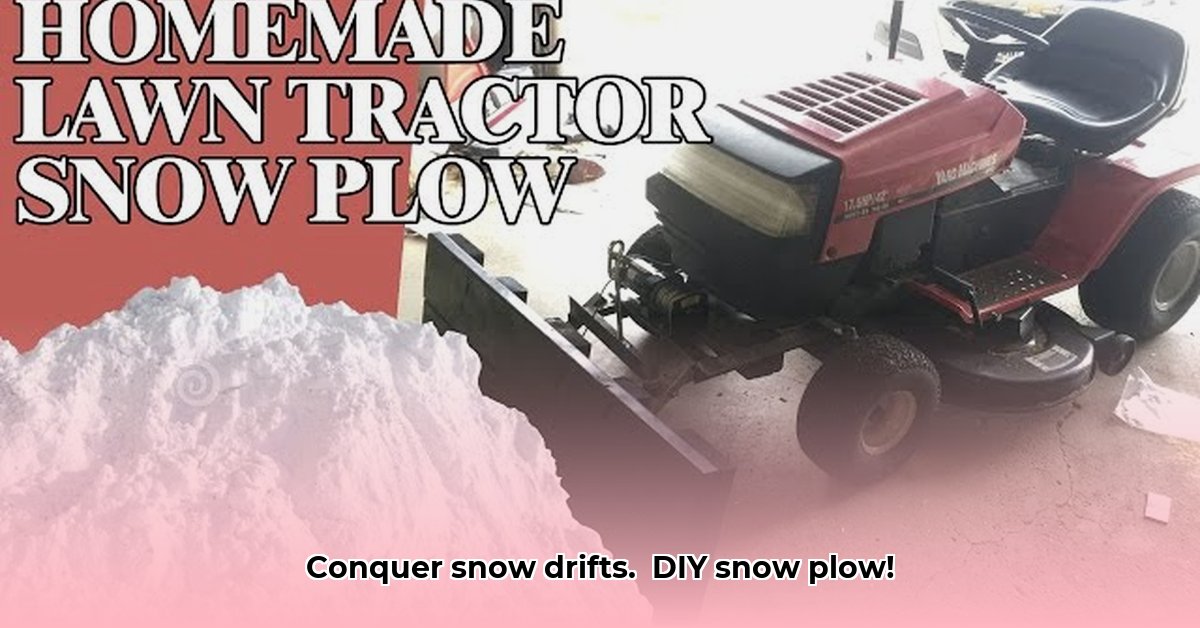
Tired of backbreaking shoveling? Transform your lawn tractor into a snow-clearing machine with a DIY snow plow! This comprehensive guide details three distinct designs, catering to various skill levels and budgets. We'll compare each approach, highlighting strengths and weaknesses, ensuring you choose the perfect project for your needs. Safety is paramount; we'll provide crucial safety guidelines throughout. For more small tractor options, check out this helpful resource: Small Tractor Guide.
Design Options: Choosing Your Snow-Fighting Strategy
Building your own snow plow offers significant cost savings and the satisfaction of a personalized solution. However, the design you choose drastically impacts durability and effectiveness. Let's explore three distinct options:
Option 1: The Simple Wooden Plow (Beginner)
This entry-level design prioritizes simplicity and affordability. Perfect for light snowfalls and smaller driveways, it's an ideal starting point for novice DIYers.
Materials: Pressure-treated lumber (for weather resistance), heavy-duty bolts, nuts, washers, angle iron (for tractor attachment), wood sealant or paint.
Instructions:
- Cut the Wood: Cut lumber into a roughly triangular shape, ensuring a gentle angle to prevent ground scraping.
- Assemble the Blade: Securely bolt the pieces together, creating a robust, single-piece blade. Use a sufficient number of bolts for strength and stability.
- Attach the Angle Iron: Weld (if experienced) or securely bolt the angle iron to the back of the blade. This will be the connection point to your tractor's hitch.
- Mount to Tractor: Carefully attach the angle iron to your tractor's hitch, ensuring a snug, stable fit. Double-check for any wobble or looseness.
- Protect Your Plow: Apply several coats of wood sealant or paint for weather protection.
Pros: Low cost, easy construction, readily available materials.
Cons: Limited durability, less effective in heavy, wet snow. May require additional bracing for support.
Option 2: The Metal Plow (Intermediate)
For superior durability and heavier snow removal, a metal plow is the better investment. This project requires welding skills and proper safety precautions.
Materials: Steel sheet metal (gauge depends on snow conditions; thicker is stronger), angle iron, welder and welding supplies, rust-resistant paint.
Instructions:
- Cut and Shape: Cut the steel sheet to your desired size and shape, creating a strong, angled blade. Consider using a metal brake or other tools to create accurate bends.
- Weld the Assembly: Securely weld the angle iron to the blade, creating a strong, unyielding structure. Use multiple welds for extra reinforcement.
- Reinforce: Add bracing to the blade for additional support against impact forces and potential bending.
- Paint and Protect: Apply several coats of rust-resistant paint to prevent corrosion and extend the plow's lifespan.
- Mount to Tractor: Securely attach the plow to your tractor’s hitch, ensuring a perfectly aligned and immovable connection.
Pros: Exceptional durability, effective in heavy snow, long lifespan.
Cons: Requires welding skills and equipment, higher cost, more time-consuming.
Option 3: Adapting Existing Equipment (Advanced)
This approach leverages existing parts (e.g., an old snowblower chute) to minimize costs. It necessitates creative problem-solving and a strong understanding of mechanics.
Instructions: This varies significantly depending on the parts used. Thoroughly assess the suitability of the selected components, ensuring proper strength and safe attachments. This might require significant modification and custom fabrication. Safety is critical!
Pros: Potentially lowest cost, highly customizable.
Cons: Requires advanced skills, less predictable outcome, significant risk of failure if not executed correctly.
Comparative Analysis: Choosing the Right Plow for You
| Feature | Wooden Plow | Metal Plow | Adapted Equipment |
|---|---|---|---|
| Estimated Cost | Low | Medium to High | Variable |
| Skill Level | Beginner | Intermediate | Advanced |
| Durability | Fair | Excellent | Variable |
| Snow-Handling | Light | Heavy | Heavy (potentially) |
| Time Commitment | Low | Medium to High | High |
Safety Precautions: Prioritize Your Well-being
Building and using a DIY snow plow involves inherent risks. Always prioritize safety by adhering to these guidelines:
- Secure Attachment: Verify the plow's secure attachment to your tractor before each use. A loose plow is incredibly dangerous.
- Protective Gear: Wear safety glasses, gloves, and sturdy footwear during both construction and operation.
- Regular Inspections: Inspect for damage or wear before each use. Address any issues immediately.
- Safe Operation: Maintain a safe speed at all times. Avoid sudden movements or sharp turns.
- Proper Lifting: Use proper lifting techniques to prevent injury when handling plow parts.
Building your own snow plow is a rewarding experience, but safety should never be compromised. Careful planning, attention to detail, and a commitment to safety are essential for a successful and incident-free project. Enjoy the snow-free driveway!